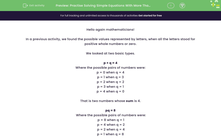In a previous activity, we found the possible values represented by letters, when all the letters stood for positive whole numbers or zero.
We looked at two basic types.
p + q = 4
Where the possible pairs of numbers were:
p = 0 when q = 4
p = 1 when q = 3
p = 2 when q = 2
p = 3 when q = 1
p = 4 when q = 0
That is two numbers whose sum is 4.
pq = 8
Where the possible pairs of numbers were:
p = 8 when q = 1
p = 4 when q = 2
p = 2 when q = 4
p = 1 when q = 8
That is two numbers whose product is 8.
In this activity, we are going to do a little work before we can identify the pairs of numbers.
Let's see what they will look like!
Example
Find all the possible values represented by a and b, when they stand for positive whole numbers or zero.
Answer
First, we need to know what the sum of a and b are, so we just want a and b on their own.
To get rid of +6 we can -6 from both sides.
Which now equals
Much easier to deal with now!
Possible pairs of numbers with a sum of 3 can now be listed.
a = 0 when b = 3
a = 1 when b = 2
a = 2 when b = 1
a = 3 when b = 0
Let's try some questions - come on!








